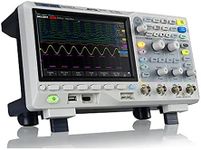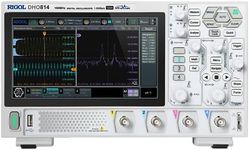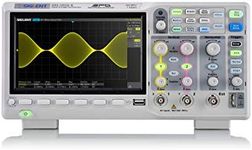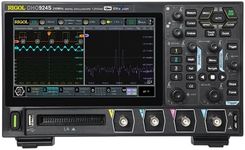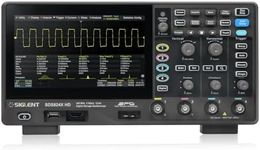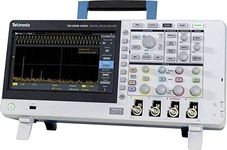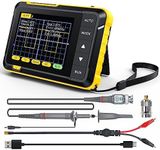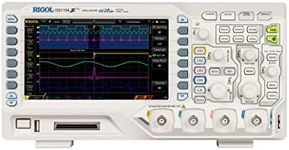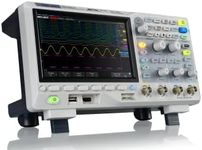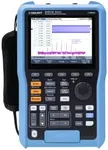Buying Guide for the Best Digital Oscilloscopes
Choosing the right digital oscilloscope can be a daunting task, especially if you're new to the field. A digital oscilloscope is an essential tool for anyone working with electronics, as it allows you to visualize electrical signals and diagnose issues in circuits. To make an informed decision, it's important to understand the key specifications and how they relate to your specific needs. Here are the main specs you should consider when selecting a digital oscilloscope.BandwidthBandwidth is the range of frequencies that the oscilloscope can accurately measure. It's important because it determines the highest frequency signal the oscilloscope can capture without distortion. Bandwidth is typically measured in megahertz (MHz) or gigahertz (GHz). For basic electronics work, a bandwidth of up to 100 MHz is usually sufficient. For more advanced applications, such as high-speed digital circuits, you might need a bandwidth of 500 MHz or more. Choose a bandwidth that is at least five times higher than the highest frequency you expect to measure.
Sample RateThe sample rate is the number of samples the oscilloscope takes per second, measured in samples per second (S/s). A higher sample rate provides more detailed and accurate representations of the signal. For general use, a sample rate of 1 to 2 gigasamples per second (GS/s) is often adequate. For capturing very fast signals, you might need a sample rate of 5 GS/s or higher. Ensure the sample rate is at least ten times the highest frequency of the signal you are measuring to avoid aliasing.
ChannelsChannels refer to the number of separate signals the oscilloscope can measure simultaneously. Most basic oscilloscopes have two channels, which is sufficient for many applications. However, if you need to compare multiple signals or work with complex circuits, you might require four or more channels. Consider the complexity of your projects and how many signals you need to monitor at once when choosing the number of channels.
Memory DepthMemory depth is the amount of data the oscilloscope can store, measured in points or samples. A deeper memory allows the oscilloscope to capture longer periods of time at high resolution. For basic tasks, a memory depth of a few megasamples (MS) is usually enough. For more detailed analysis or capturing long-duration signals, you might need a memory depth of 10 MS or more. Choose a memory depth that matches the duration and complexity of the signals you need to capture.
DisplayThe display is where you view the captured signals. A larger, higher-resolution display makes it easier to see fine details and analyze signals. Look for an oscilloscope with a clear, bright display, preferably with a resolution of at least 800x480 pixels. Touchscreen displays can also enhance usability, allowing you to easily navigate menus and adjust settings. Consider how much time you'll spend analyzing signals and choose a display that will be comfortable for extended use.
TriggeringTriggering is a feature that allows the oscilloscope to stabilize repetitive waveforms and capture specific events. It's important because it helps you isolate and analyze particular parts of a signal. Common trigger types include edge, pulse, and video triggers. For basic use, edge triggering is often sufficient. For more complex signals, look for an oscilloscope with advanced triggering options. Consider the types of signals you'll be working with and choose an oscilloscope with the appropriate triggering capabilities.
ConnectivityConnectivity options, such as USB, Ethernet, and Wi-Fi, allow you to transfer data to a computer or network for further analysis and storage. This is important for documenting your work and sharing results. Basic oscilloscopes usually have USB ports, while more advanced models may offer additional connectivity options. Consider how you plan to use the oscilloscope and whether you need to transfer data frequently. Choose an oscilloscope with the connectivity features that match your workflow.
Form FactorThe form factor refers to the physical size and portability of the oscilloscope. Benchtop oscilloscopes are larger and typically offer more features, making them suitable for lab environments. Portable or handheld oscilloscopes are smaller and easier to carry, ideal for fieldwork or on-site troubleshooting. Consider where you'll be using the oscilloscope and how often you'll need to move it. Choose a form factor that fits your working environment and mobility needs.
